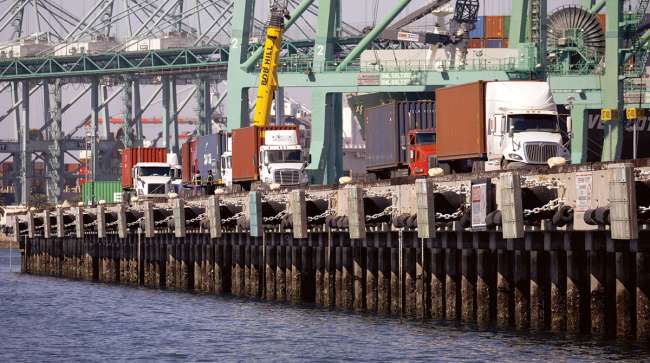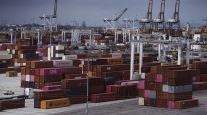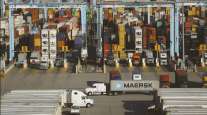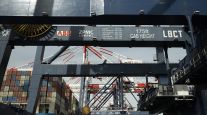Senior Reporter
Ports Continue to Set Records; Congestion Worsens on West Coast

[Stay on top of transportation news: Get TTNews in your inbox.]
More than 60 containerships sat in San Pedro Bay on Feb. 18, at the entrance to the sprawling ports of Los Angeles and Long Beach. The vessels are waiting for a slot to sail into those facilities to begin unloading their cargo and then start the nearly two-week trip back to China.
But because of the historically high volume of imports, a shortage of warehouse space, and now COVID-19 concerns among longshoremen, the backlog to move freight is worsening.
RELATED: U.S. pressures container carriers to ease port congestion
“If we do nothing, we will still have vessels at anchor come midsummer,” Port of Los Angeles Executive Director Gene Seroka said.
The nation’s busiest port, Los Angeles, processed 835,516 20-foot-equivalent containers in January, up 3.6% compared with 2020’s 806,143. Officials said January marked the sixth consecutive month of year-over-year increases as U.S. consumer spending continues to drive demand for goods.
The #PortofLA processed 835,516 Twenty-Foot Equivalent Units (TEUs) in January 2021, an increase of 3.6% compared to January 2020. It was the sixth consecutive month of year-over-year increases as U.S. consumer spending continues to drive demand for goods. https://t.co/SOwljgxwwA pic.twitter.com/htXk9Ea0cD — Port of Los Angeles (@PortofLA) February 17, 2021
“All indications point toward a strong flow of imports over the next few months as consumers continue an unprecedented buying surge which began last summer,” Seroka said. “However, U.S. exports continue to lag, down 25 of the last 27 months. What we’re experiencing is one-way trade, which has created challenges for the entire supply chain."
Even with the extensive economic devastation caused in the second quarter of 2020 by the COVID-19 pandemic, the port finished down 1.3% year-over-year, processing 9,213,386 containers in 2020 compared with 9,337,632 the previous year.
“If the ships are sitting at anchor, they can’t be unloading or steaming back to Asia to reload with more cargo,” IHS Markit Transportation Economist Paul Bingham told Transport Topics. This is jamming up the whole system. “The demand for imports is so strong.”
The Port of Long Beach said container volumes in January were up 21.9% year-over-year as workers processed 764,006 TEUs compared with 626,829 last year. Year-over-year, the port moved a record 8,113,315 containers compared with 7,632,032 in 2019.
“After the volatility with cargo volumes in 2020, we hope to see some stability and continued economic recovery over the next year as we remain focused on attracting business and building for the future,” Port of Long Beach Executive Director Mario Cordero said.
The longshoremen are working every shift they can. But they’ve been hampered by COVID.
IHS Markit Transportation Economist Paul Bingham
Bingham said West Coast ports are feeling the pandemic’s impact, and in some cases, there is a shortage of longshoremen. Port of Los Angeles officials confirmed that 800, or 10%, of registered or regular workers were out last week. The pool of dockworkers is made up of 8,000 registered workers and 7,000 apprentices.
“The longshoremen are working every shift they can. But they’ve been hampered by COVID,” he said. “The COVID count here was approaching 1,000 last week. They’re not all out. But they have to go into quarantine when they get a positive test. They’re tested regularly.”
The Port of Oakland reported moving 199,098 containers in January, down 5.7% versus 211,251 the year before. The facility was down 1.56% for all of 2020, processing 2,461,279 containers in 2020 compared with 2,500,461 in 2019.
Even with the monthly and yearly declines, experts expect Oakland to be the beneficiary this spring because of the increased congestion at Long Beach and Los Angeles.
Momentous time with arrival of CMA CGM's first call Asia service; Golden Gate Bridge service began on Lunar New Year. Thank you (Merci bien!) @cmacgm for sharing these beautiful photos of the first ship in the service rotation! #maritime #oakland #logistics #freightforwarders pic.twitter.com/yEbBYGh9RJ — Port of Oakland (@PortofOakland) February 15, 2021
The Port of Oakland on Feb. 17 announced a change to its business model. Called the Golden Gate Bridge service, it links Oakland directly to ports in Shanghai, Yantian and Kaohsiung in southern Taiwan. Port officials said the service would speed up shipments to Oakland and then move predominantly by rail to Midwest depots, including Chicago and Memphis, Tenn.
“Our customers can significantly improve the transit time for getting their products to consumers with a first call and also use Oakland to reach the U.S. interior through our rail connections,” Port of Oakland Maritime Director Bryan Brandes said.
The Northwest Seaport Alliance, consisting of the ports of Seattle and Tacoma, Wash., reported January volume of 288,289 containers, a 9.3% rise over 263,819 a year earlier. For all of 2020, the facility experienced a 12% drop, to 3,320,279 from 3,775,626 in 2019.
In January, we handled more than 270,000 TEUs of our customers' cargo, a 17.2% increase from January 2020. We ended January with a 38.5 minute traditional turn time, and 33.3 hour rail ready dwell. You can read the full release here: https://t.co/hFhtVsXaWA#cargo #maritime pic.twitter.com/9DceflMWip — The Port of Virginia (@PortofVirginia) February 12, 2021
On the East Coast, the Port of Virginia saw a 19.2% jump in cargo volume, processing a January-record 270,969 TEUs compared with 227,234 in the 2020 period. Even with the second-quarter economic downturn, the port finished 2020 with a 5.8% year-over-year increase, processing 1,810,268 containers compared with 1,710,743 in 2020.
The South Carolina Port Authority, which operates the Port of Charleston, said it had a 2.5% year-over-year increase to 216,265 containers versus 211,020 in 2020.
The port operates on a fiscal July-to-July calendar, and at the midpoint of the year, the facility is on pace with 2020.
Georgia’s Port of Savannah notched a 21.7% year-over-year increase in January, moving 459,608 containers compared with 377,672 in the 2020 period. The Georgia facility has set volume records the past four months, moving more than 445,000 units on each occasion. Even with a slump in the first and second quarters of 2020, the facility broke 2019’s all-time high for containers by 1.8%, processing 4,682,255 containers, compared with 4,599,172 in 2020.
The Port Authority of New York and New Jersey and Port Houston did not have container numbers available as of Feb. 18.
Want more news? Listen to today's daily briefing below or go here for more info:





